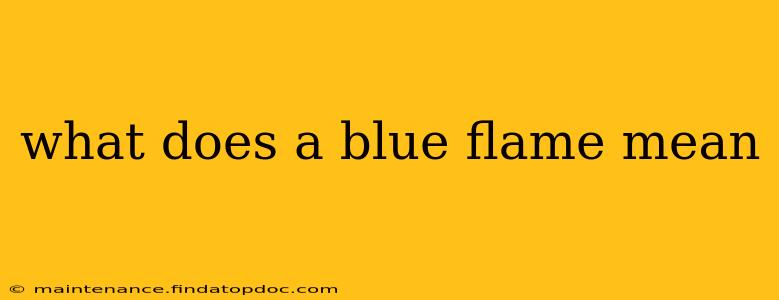A blue flame, often seen in gas stoves or specialized burners, signifies a hotter and more efficient burn compared to a yellow or orange flame. The color difference stems from the way the fuel is combusting and the temperature at which it does so. Let's delve deeper into the science and explore some common questions surrounding blue flames.
Why is my flame blue?
The color of a flame is determined by the temperature and the completeness of combustion. A blue flame indicates complete combustion, meaning the fuel (usually natural gas or propane) is reacting fully with oxygen. This complete reaction produces a higher temperature, resulting in the blue color. The blue color itself comes from the emission of excited molecules of carbon dioxide and water vapor at high temperatures. These molecules emit light in the blue portion of the visible spectrum.
What causes a blue flame vs. a yellow flame?
A yellow or orange flame signifies incomplete combustion. This occurs when there isn't enough oxygen available for the fuel to react completely. Incomplete combustion produces soot (unburnt carbon particles) which glows orange or yellow, creating a less efficient and cooler burn. In addition to being less efficient, incomplete combustion can produce harmful byproducts like carbon monoxide, highlighting the importance of proper ventilation when using gas appliances.
Is a blue flame hotter than a yellow flame?
Yes, a blue flame is significantly hotter than a yellow flame. Complete combustion in a blue flame releases more energy, leading to higher temperatures. This higher temperature is ideal for cooking, as it allows for faster and more even heating.
What does a blue flame on a gas stove mean?
A blue flame on your gas stove indicates that the burner is functioning correctly and achieving complete combustion. It means you are getting optimal heat output and efficient fuel utilization. If you see a yellow or orange tip, it might indicate a need for adjustment or cleaning of the burner.
Is a blue flame dangerous?
While a blue flame itself isn't inherently dangerous, it's crucial to ensure you have proper ventilation when using gas appliances. Even with complete combustion, some combustion products, like carbon dioxide, can build up to dangerous levels in poorly ventilated spaces. Always ensure your gas appliances are properly installed and maintained and that you have adequate ventilation in the area.
What should I do if my gas stove flame is yellow?
A yellow flame on your gas stove often signifies insufficient oxygen reaching the burner. This could be due to a clogged burner port, a blockage in the gas supply, or poor ventilation. You should consult your stove's manual or a qualified gas technician to address the issue. Attempting to fix this yourself could be dangerous, particularly if you are unfamiliar with gas appliances.
How can I get a blue flame?
To ensure a blue flame, maintain your gas appliances regularly, cleaning any debris from the burner ports. Proper ventilation is also critical. If you are still experiencing yellow flames after cleaning, it's best to seek professional help.
This comprehensive explanation delves into the reasons behind the color of a flame, highlighting the importance of complete combustion for efficiency and safety. Understanding these factors helps ensure the safe and effective use of gas appliances in your home.
